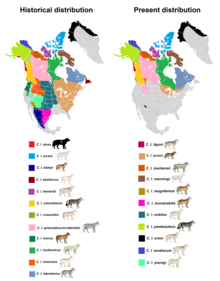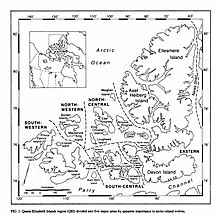
There are 38 subspecies of Canis lupus listed in the taxonomic authority Mammal Species of the World. These subspecies were named over the past 250 years, and since their naming, a number of them have gone extinct. The nominate subspecies is the Eurasian wolf.

The wolf, also known as the gray wolf or grey wolf, is a large canine native to Eurasia and North America. More than thirty subspecies of Canis lupus have been recognized, including the dog and dingo, though gray wolves, as popularly understood, only comprise naturally-occurring wild subspecies. The wolf is the largest extant member of the family Canidae, and is further distinguished from other Canis species by its less pointed ears and muzzle, as well as a shorter torso and a longer tail. The wolf is nonetheless related closely enough to smaller Canis species, such as the coyote and the golden jackal, to produce fertile hybrids with them. The wolf's fur is usually mottled white, brown, gray, and black, although subspecies in the arctic region may be nearly all white.

Ellesmere Island is Canada's northernmost and third largest island, and the tenth largest in the world. It comprises an area of 196,236 km2 (75,767 sq mi), slightly smaller than Great Britain, and the total length of the island is 830 km (520 mi).

Baffin Island, in the Canadian territory of Nunavut, is the largest island in Canada and the fifth-largest island in the world. Its area is 507,451 km2 (195,928 sq mi) with a population density of 0.03/km²; the population was 13,039 according to the 2021 Canadian census; and it is located at 68°N70°W. It also contains the city of Iqaluit, which is the capital of Nunavut.

The Arctic hare is a species of hare highly adapted to living in the Arctic tundra and other icy biomes. The Arctic hare survives with shortened ears and limbs, a small nose, fat that makes up close to 20% of its body, and a thick coat of fur. It usually digs holes in the ground or under the snow to keep warm and to sleep. Arctic hares look like rabbits but have shorter ears, are taller when standing, and, unlike rabbits, can thrive in extreme cold. They can travel together with many other hares, sometimes huddling with dozens or more, but are usually found alone, sometimes taking more than one partner. The Arctic hare can run up to 60 kilometres per hour (40 mph).

The muskox, also spelled musk ox and musk-ox, plural muskoxen or musk oxen, is a hoofed mammal of the family Bovidae. Native to the Arctic, it is noted for its thick coat and for the strong odor emitted by males during the seasonal rut, from which its name derives. This musky odor has the effect of attracting females during mating season. Its Inuktitut name "umingmak" translates to "the bearded one".

The eastern wolf also known as the timber wolf, Algonquin wolf or eastern timber wolf, is a canine of debated taxonomy native to the Great Lakes region and southeastern Canada. It is considered to be either a unique subspecies of gray wolf or red wolf or a separate species from both. Many studies have found the eastern wolf to be the product of ancient and recent genetic admixture between the gray wolf and the coyote, while other studies have found some or all populations of the eastern wolf, as well as coyotes, originally separated from a common ancestor with the wolf over 1 million years ago and that these populations of the eastern wolf may be the same species as or a closely related species to the red wolf of the Southeastern United States. Regardless of its status, it is regarded as unique and therefore worthy of conservation with Canada citing the population in eastern Canada as being the eastern wolf population subject to protection.

The Hokkaido wolf, also known as the Ezo wolf and in Russia as the Sakhalin wolf, is an extinct subspecies of gray wolf that once inhabited coastal northeast Asia. Its nearest relatives were the wolves of North America rather than Asia. It was exterminated in Hokkaido during the Meiji Restoration period, when American-style agricultural reforms incorporated the use of strychnine-laced baits to kill livestock predators. Some taxonomists believe that it survived up until 1945 on the island of Sakhalin. It was one of two subspecies that were once found in the Japanese archipelago, the other being the Japanese wolf.

The northwestern wolf, also known as the Mackenzie Valley wolf, Alaskan timber wolf, or Canadian timber wolf, is a subspecies of gray wolf in western North America. Arguably the largest gray wolf subspecies in the world, it ranges from Alaska, the upper Mackenzie River Valley; southward throughout the western Canadian provinces, aside from prairie landscapes in its southern portions, as well as the Northwestern United States.
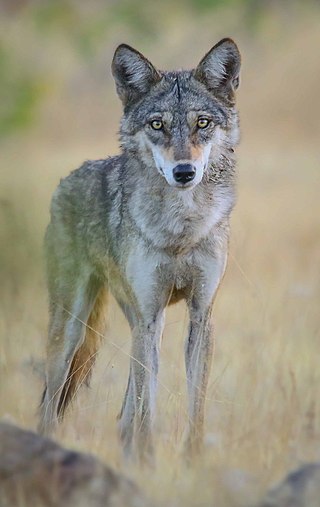
The Indian wolf is a subspecies of gray wolf that ranges from Southwest Asia to the Indian subcontinent. It is intermediate in size between the Himalayan wolf and the Arabian wolf, and lacks the former's luxuriant winter coat due to it living in warmer conditions. Within this subspecies, the "Indian plains wolf" is genetically basal to all other extant Canis lupus apart from the older-lineage Himalayan wolf, with both proposed as separate species. The Indian wolf travels in smaller packs and is less vocal than other variants of the gray wolf, and has a reputation for being cunning. The Indian wolf is one of the most endangered populations of gray wolf in the world.
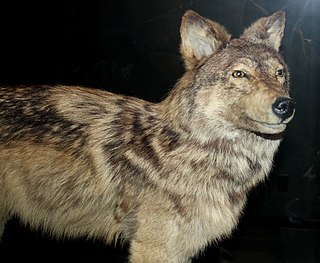
The Newfoundland wolf was a subspecies of grey wolf that was native to Newfoundland. As a food source, the species would prey and rely on the Newfoundland caribou. During the autumn and early winter, some wolves would turn white while others remained dark enough to look black.

Bernard's wolf, also known as the Banks Island wolf or the Banks Island tundra wolf, is an extinct subspecies of the gray wolf that was limited to Banks and Victoria Island of the Arctic Archipelago.

The British Columbia wolf is a subspecies of gray wolf which lives in a narrow region that includes those parts of the mainland coast and near-shore islands that are covered with temperate rainforest, which extends from Vancouver Island, British Columbia, to the Alexander Archipelago in south-east Alaska. This area is bounded by the Coast Mountains.

The Labrador wolf is a subspecies of gray wolf native to Labrador and northern Quebec. It has been described as ranging in color from dark grizzly-gray to almost white, and of being closely related to the Newfoundland wolf. This wolf is recognized as a subspecies of Canis lupus in the taxonomic authority Mammal Species of the World (2005).
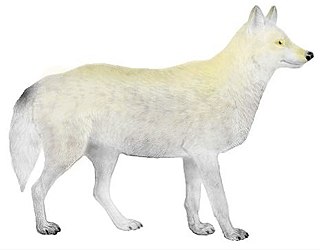
The Baffin Island wolf, also known as the Baffin Island tundra wolf, is a subspecies of grey wolf which resides exclusively on Baffin Island and several nearby islands. It was not formally recognized as a subspecies until 1943, when it was given its taxonomic classification by Anderson. This wolf is recognized as a subspecies of Canis lupus in the taxonomic authority Mammal Species of the World (2005).

The Greenland wolf is a subspecies of gray wolf that is native to Greenland. Historically, it was heavily persecuted, but today it is fully protected and about 90% of the wolf's range falls within the boundaries of the Northeast Greenland National Park.

The Beringian wolf is an extinct population of wolf that lived during the Ice Age. It inhabited what is now modern-day Alaska, Yukon, and northern British Columbia. Some of these wolves survived well into the Holocene. The Beringian wolf is an ecomorph of the gray wolf and has been comprehensively studied using a range of scientific techniques, yielding new information on their prey species and feeding behaviors. It has been determined that these wolves are morphologically distinct from modern North American wolves and genetically basal to most modern and extinct wolves. The Beringian wolf has not been assigned a subspecies classification and its relationship with the extinct European cave wolf is not clear.

The Pleistocene wolf, also referred to as the Late Pleistocene wolf, is an extinct lineage or ecomorph of the grey wolf. It was a Late Pleistocene 129 Ka – early Holocene 11 Ka hypercarnivore. While comparable in size to a big modern grey wolf, it possessed a shorter, broader palate with large carnassial teeth relative to its overall skull size, allowing it to prey and scavenge on Pleistocene megafauna. Such an adaptation is an example of phenotypic plasticity. It was once distributed across the northern Holarctic. Phylogenetic evidence indicates that despite being much smaller than the prehistoric wolf, the Japanese wolf, which went extinct in the early 20th century, was of a Pleistocene wolf lineage, thus extending its survival to several millennia after its previous estimated extinction around 7,500 years ago.

Single wolves or mated pairs typically have higher success rates in hunting than do large packs; single wolves have occasionally been observed to kill large prey such as moose, bison and muskoxen unaided. This contrasts with the commonly held belief that larger packs benefit from cooperative hunting to bring down large game. The size of a wolf hunting pack is related to the number of pups that survived the previous winter, adult survival, and the rate of dispersing wolves leaving the pack. The optimal pack size for hunting elk is four wolves, and for bison a large pack size is more successful.

The Canadian High Arctic Tundra ecoregion encompasses most of the northern Arctic archipelago, from much of Baffin Island, Somerset Island, and Prince of Wales Island in the south, through all islands northward to the most northern island in Canada, Ellesmere Island. Much of the northern islands are covered in ice, and the climate is very dry with as little as 50 mm/year in places. The ecoregion has very little human habitation, and most of the non-ice terrain is moss and lichen cover. The region supports viable populations of arctic mammals such as muskox, arctic wolves, arctic foxes, arctic hares, polar bears, and caribou.

